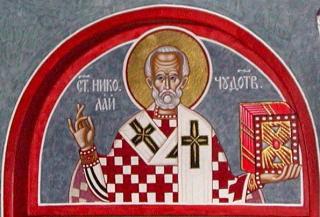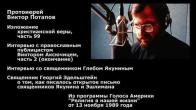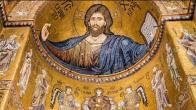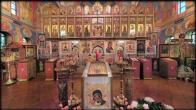You are here
St. Nicholas the Wonderworker, archbishop of Myra in Lycia
6/19 December
Troparion, Fourth Tone
The truth of things revealed thee to thy flock as a rule of faith, an icon of meekness and a teacher of temperance; therefore thou hast achieved the heights by humility, riches by poverty. O Father and Hierarch Nicholas, intercede with Christ God that our souls be saved.
Holy Hierarch Nicholas the Wonderworker, Archbishop of Myra in Lycia, was glorified as a great saint of God. He was born in the city of Patara in Lycia (on the southern coast of the peninsula of Asia Minor). He was the only son of the pious Theophanes and Nona, who had promised to dedicate him to God. The child Nicholas, fruit of prolonged prayer offered to the Lord by the childless couple, shone forth to the people his future glory as a great miracle-worker. Immediately after giving birth to him, his mother Nona was healed of sickness. From infancy, St. Nicholas set out on a life of fasting. On Wednesdays and Fridays, he accepted his mother’s milk only once, after his parents’ evening prayers.
From childhood, Nicholas became accomplished in learning Divine Scripture. During the day, he did not leave the church, and at night he prayed and read books, building within himself a worthy home for the Holy Spirit. His uncle, Bishop Nicholas of Patara, rejoiced in his spiritual accomplishments. He tonsured Nicholas as a reader, then elevated him to the priesthood, and made him his assistant, assigning him to educate the flock. In serving the Lord, the youth was on fire with the Spirit. In his proficiency with respect to questions of faith, he was like an elder and evoked amazement and profound respect on the part of the faithful. Constantly working and vigilant, remaining in prayer without ceasing, the presbyter Nicholas showed great charity toward his flock, coming to the aid of the suffering, and giving all he possessed to the poor. Hearing of the bitter need and poverty of a formerly wealthy resident of his city, St. Nicholas saved him from committing a great sin. The despondent parent of three adult daughters was contemplating giving them over to a life of fornication in order to stave off starvation. Sorrowing over the perishing sinner, the Holy Hierarch secretly threw three bags of gold through his window during the night, and thereby saved the family from degradation and spiritual ruin. Holy Hierarch Nicholas always strove to do acts of charity in secret, and to hide his acts of kindness.
Upon setting out to venerate the holy sites in Jerusalem, the bishop of Patara entrusted the administration of his flock to St. Nicholas, who assiduously carried out his assignment with love. When the bishop returned, St. Nicholas in turn asked his blessing to travel to the Holy Land. Along the way, the saint predicted the coming of a storm which would put the ship in danger of sinking, for he had seen the devil himself board the ship. In answer to the pleas of the despairing travelers, he used his prayer to calm the waves. By his prayers, a ship’s crewmember who sustained fatal injuries in a fall from the mast was restored to health.
At the ancient city of Jerusalem, St. Nicholas ascended Golgotha and gave thanks to the Savior of mankind. He bowed down and prayed at all of the holy sites. At night, upon the approach of the great pilgrim, the locked doors of the church on Mt. Zion opened by themselves. Having gone to all of the holy sites connected with the earthly service of the Son of God, St. Nicholas decided to go off into the dessert. He was stopped by a Divine voice which directed that he return to his homeland. Drawn to a life of silence, upon his return to Lycia the saint joined the brotherhood of a monastery known as Holy Zion. However, the Lord once again announced to him that a different path awaited him: “Nicholas, this is not field from which I expect you to bring forth My expected fruit. Turn and go back into the world, that My Name will be glorified in you.” In a vision, the Lord gave him the Gospels, bound in a richly decorated cover, and the Most-Holy Mother of God gave him an omophorion.
And so it came to pass: After the death of Archbishop John, one of the bishops in the Council deciding who was to chosen to be the new archbishop was shown in a vision that the chosen one of God was St. Nicholas; thereafter, he was chosen to be bishop of Myra in Lycia. Called to shepherd the Church of God in the dignity of a hierarch, Holy Hierarch Nicholas remained the same great spiritual struggler, manifesting to his flock the image of meekness, mildness and love towards man. This was especially valuable to the Church of Lycia during the period of persecution of Christians in the reign of emperor Diocletian (284-305). Bishop Nicholas, locked up in prison together with other Christians, lent them support, and exhorted them to firmly endure their bonds, trials and torture. The Lord kept him from harm. After the coronation of the Equal-to-the-Apostles Constantine, Nicholas was returned to his flock, which joyously greeted its teacher and intercessor. Despite his great meekness of spirit and purity of heart, Holy Hierarch Nicholas was a zealous and courageous warrior of the Church of Christ. Doing battle with the spirits of evil, the Holy Hierarch visited the pagan temples of the city of Myra and the surrounding area, smashing the idols and turning their temples into rubble. In 325, Holy Hierarch Nicholas was a participant in the 1st Ecumenical Council, at which the Nicene Creed was adopted, and along with Sts. Sylvester, Pope of Rome, Alexander of Alexandria, Spyridon of Trimethus, and others among the 318 Holy Fathers of the Council, he took up arms against the heretic Arius.
Burning with zeal for the Lord, and in the heat of denouncing Arius, the Holy Hierarch Nicholas even boxed the ears of the teacher of false doctrine. For this, he was stripped of his episcopal omophorion and placed under guard. However, several of the holy fathers had a vision in which the Lord Himself and the Mother of God consecrated the Saint a bishop, handing him the Gospels and the omophorion. The Fathers of the Council, perceiving that the Holy Hierarch’s zeal and daring were pleasing to God, glorified God, and restored His Saint to his episcopal rank. Returning to his diocese, the Holy Hierarch brought to it peace and blessing, sowing the word of Truth, cutting off at the roots incorrect thinking and vain philosophizing, denouncing entrenched heretics and tending to those who had unknowingly fallen and turned away from the path. He was truly a light for the world and the salt of the earth, for his life was bright and his word was permeated with the salt of wisdom.
During his lifetime, the Holy Hierarch worked many miracles. From among them, he garnered the most fame for saving from death three men unjustly condemned by a greedy town governor. The Holy Hierarch bravely approached the executioner and held back the sword, which was already raised over the heads of the condemned. Having his injustice unmasked by Holy Hierarch Nicholas, the town governor repented and asked his forgiveness. Three military leaders sent by Emperor Constantine to Phrygia were also present. They could not yet have imagined that, having been slandered before the Emperor and condemned to death, they would soon likewise seek the intercession of Holy Hierarch Nicholas. Holy Hierarch Nicholas appeared to Equal-to-the-Apostles Constantine and challenged him to release the unjustly condemned military leaders who, lying in prison, were prayerfully entreating the Saint for his help. He worked many other miracles during the long years of his service. By the prayers of the Holy Hierarch, the city of Myra was saved from a great famine. He appeared to a certain Italian merchant, and giving him three gold coins (which, upon awaking, the merchant found in his hand), he asked the merchant to bring his ship to Myra, and there sell his grain. On many occasions, the Holy Hierarch saved those drowning at sea, and set free those in prisons and dungeons.
Having lived to a very old age, Holy Hierarch Nicholas peacefully departed to the Lord (+345-351). His honorable and incorrupt relics were kept in the local cathedral church and exuded health-giving myrrh, from which many received healings. In 1087, his relics were translated to the Italian city of Bari, where they remain to this day (see 9 May for an account of the translation.)
The name of the great Saint of God, the Holy Hierarch and Miracle-worker Nicholas, the quick helper and man of prayer for all who run to him, became famous in many countries and among many peoples throughout the world. In Russia, many cathedrals, monasteries, and churches are dedicated to his holy name. No, rather, there is not a single town without a church dedicated to St. Nicholas. More often than not, churches to St. Nicholas were erected on market squares by Russian merchants, those who sailed the seas and who trod the earth, those who revered St. Nicholas the Miracle-worker as the patron of all travelers, both on land and on sea. Sometimes the people named them churches of “Nichola the Wet.” Many village churches were dedicated to the Wonder-worker Nicholas, whom peasants revered as a merciful intercessor for all working people before the Lord. Holy Hierarch Nicholas did not cease acting as an intercessor for the Russian land. Ancient Kiev passed down to us the story of how the Holy Hierarch saved a drowned child. After hearing the sorrowful prayers of parents who had lost their only heir, St. Nicholas took the child from the water, brought him back to life, and placed him before his miraculous icon in the choir loft of the Church of the Holy Wisdom. In the morning, the parents were overjoyed to find their rescued child there. Together with a multitude of people, they glorified St. Nicholas the Wonder-worker.
Many miraculous icons of St. Nicholas appeared in Russia, or came to Russia from other countries. These include the ancient (12th century) Byzantine icon, brought from Novgorod to Moscow and depicting the Saint to the waist, as well as the enormous icon, written in the 13th century by a Novgorod master. Two types of depictions of the Wonder-worker are especially wide-spread throughout the Russian Church: The first is Holy Hierarch Nicholas of Zaraisk, showing a full-length figure of St. Nicholas, his right hand in an attitude of blessing, and his left holding the Gospels. It was this icon that was brought to Ryazan’ in 1225 by the Byzantine Princess Eupraxia, who married Theodore, Prince of Ryazan’, and who perished, together with her husband and her infant son, during the invasion by Baty Khan. The second is Holy Hierarch Nicholas of Mozhaisk, which also depicts a full-length figure of St. Nicholas, holding a sword in his right hand and a city in his left. This commemorates the miraculous saving, through the prayers of the Holy Hierarch, of the city of Mozhaisk from enemy attack. It would be impossible to list all of the grace-giving icons of Holy Hierarch Nicholas. According to the prayers of the Holy Hierarch, every Russian town and every church is blessed with such an icon.
Relics in cathedral - monthly calendar
| S | M | T | W | T | F | S |
|---|---|---|---|---|---|---|
|
|
|
|
1
|
2
|
3
|
4
|
|
5
|
6
|
7
|
8
|
9
|
10
|
11
|
|
12
|
13
|
14
|
15
|
16
|
17
|
18
|
|
19
|
20
|
21
|
22
|
23
|
24
|
25
|
|
26
|
27
|
28
|
29
|
30
|
31
|
|
PARISH LIFE
Address of our Cathedral
While all the materials on this site are copyrighted, you may use them freely as long as you treat them
with respect and provide attribution on the Russian Orthodox Cathedral of St.John the Baptist of Washington DC.










